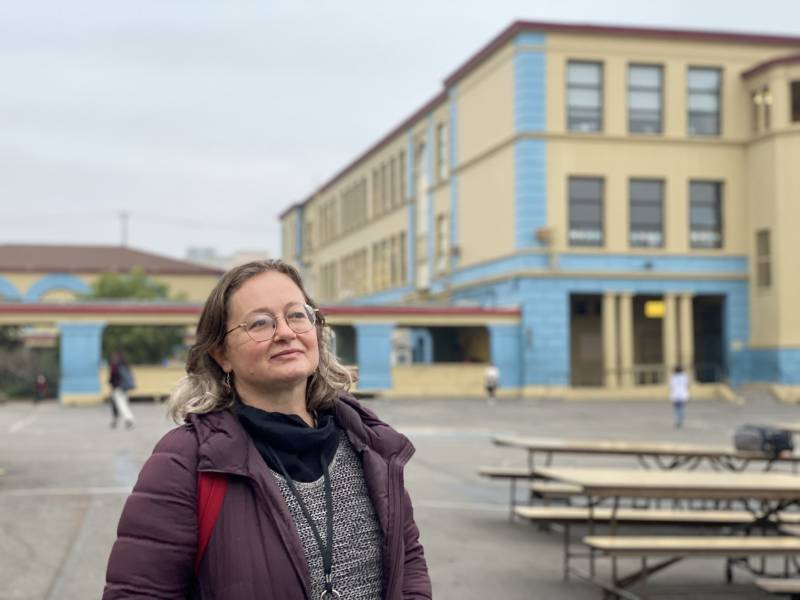Bijur says the staff she is missing could be helping folks complete the application process, which can include locating old SAT scores and other data not readily available.
“It’s actually not easy to become a substitute. You have to submit transcripts and you have to submit an assessment of basic skills,” Bijur explained.
The district has been trying to attract bilingual immigrant parents who might already be volunteering in their child’s elementary school classroom to the job.
“Every single night, every night, it keeps me awake,” Bijur says. “The single most important factor in a child’s education is the quality of their teacher.”
Districts trying new ways to attract substitutes
At SFUSD, Bijur is trying to come up with new ways of getting more people to help staff schools. She wants to work with the district’s corporate partners to have them send in service day volunteers to handle playground duty, freeing up those staff to fill in on classroom teaching, for example.
And Bijur is also looking into ways to get more student teachers emergency credentials to sub. Student teachers are graduate students working toward their teaching degree who often train in public school classrooms.
If she succeeds, however, Bijur says any who are newly credentialed as subs would go straight into the 36 district classrooms that still don’t have a permanent teacher in them this year.
(In San Diego, some school districts have mailed letters directly to parents asking them to step in and help. Others have turned to Tiktok to recruit.)
Berkeley Unified also is working to get more student teachers emergency credentials.
“A huge and frustrating irony in all this is that we have student teachers who would love to sub, and desperately need the money since they are in grad school,” said Berkeley High teacher Dana Moran in an email.
“But staff shortages and backlogs at the district, state, and ACOE have made it impossible for them to get certified to sub,” she said, referencing the Alameda County Office of Education. “They have literally been trying to get on the sub list since August and still have not been approved.”
In Oakland, the district has been able to hire 104 new subs this year by contracting with companies like ZipRecruiter and Indeed to target substitute recruitment. The district has moved to video screening for the sub interviews to move things along, and they’ve increased the pay rate to that of a first-year teacher’s salary.
However, OUSD does not provide health benefits for nonpermanent, day-to-day subs.
Oakland sub Craig Gordon, who is a retired teacher, says the district could attract more retired teachers like him back into the sub pool if it would agree to cover the costs of health care should they contract COVID-19 while on the job. Retired teachers don’t have to go through the same screening process when they want to return as a sub since they’re already credentialed.
“And so we have asked for some kind of formula whereby a substitute who is working would get health care benefits, too. But they are refusing to negotiate any of that right now,” said Gordon.
According to state law, on Jan. 1, teachers who retired six months ago are eligible to work as subs, and many districts said they are hoping those teachers can be persuaded to come back to the classroom a few days a week to fill in
But older teachers also can be more hesitant to work in classrooms during the pandemic, especially during the current surge. Furthermore, aside from concerns about omicron breakthrough cases, some potential subs also are balking at working in schools that are so understaffed they’re having a hard time functioning.
In Marin County, where the sub pool has shrunk from about 500 to 300, previous recruitment methods just aren’t working, said Tracee Edmunds, director of personnel with the Marin County Office of Education. She says districts have to actively reach out to people and leverage the networks that already exist to try to solve the sub shortage.
“It’s going to go beyond just the responsibility of the HR offices,” Edmunds said. “Everyone’s going to have to get involved, including the school site staff recruiting parents, people reaching out to members of the community and coming together as a village to help solve the staffing shortage.”
The Marin County Superintendent of Schools Office is spearheading an effort to find new substitute prospects by approaching people in line at vaccination clinics, for example. Edmunds says the district wants to appeal to the county’s retired residents who may be willing to sub one or two days a week.
But Edmunds predicts it will take years to build back up the staffing of substitutes.
“I think it is something that districts are going to be working on for years to come in building back up the staffing for our substitutes and public education,” she said.
“With people moving out of the state and removing themselves due to COVID-related concerns,” she said, “we have a long road ahead of us to bring back really great quality substitutes to replace our teachers.”

